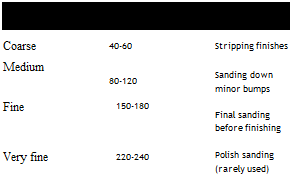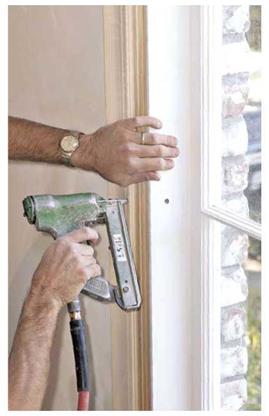NAILING AND DRILLING
Because most trim is light, it is usually nailed up with finish nails, which have slimmer shanks and smaller heads than other nails. Trim-head screws (shown in the photo on p. 90) are often specified when molding is heavy or complex or when trim pieces will be subject to twisting or flexing, as happens with door frames and stair treads.
A finish hammer has a smaller head than a framing hammer and so is easier to control when trying to avoid denting the trim. Stop when the nail head is almost flush with the wood surface; then use a nail set to drive the nail head below the surface. Always set nails before sanding or finishing.
Finish nailers have largely replaced hand nailing, because pressure settings can be adjusted so the nail goes just below the surface; thus you don’t have to set the nails. Finish nailers won’t dent trim, and you can nail with one hand while holding joints together with the other. Production carpenters favor pneumatic models with air hoses running to a compressor, but cordless models with spare batteries work well, too, for installing small amounts of trim.
Nailers are designed to shoot specific nail gauges (thicknesses). Standard finish nailers


![]()
![]()
shoot 15-gauge nails, whereas brad nailers (pin tackers) shoot 18-gauge to 20-gauge brads. (The higher the gauge number, the thinner the nail shank and the weaker the nail.) Most homeowners should stick with 15-gauge nailers, but brad nailers are great for tacking up trim: Brad holes are tiny, so you can easily pry off and reposition the trim if needed. Brads are also useful for attaching thin cabinet elements like finish toekicks or cabinet side panels. If you don’t have many brads to drive, use a hand brad pusher.
Cordless drill drivers are the essential tool in most carpenters’ belts. Although they range up to h-in., 18-volt monsters, unless you’ve got forearms like Popeye get a 18-in., 12-volt cordless drill-driver, which has a keyless chuck for quick changing of bits. A 12-volt model accepts either drill bits or screw tips and has plenty of power for finish carpentry tasks. For production carpenters, the next step up in power (and price) is a 12-volt impact driver, which accepts only screw tips; some models can drive more than 250 two – inch screws on a single battery charge. (Whichever tool you buy, get a spare battery for recharging while you work with the other one.) You’ll find more on drills, drivers, and bits in Chapter 3.
|
When it comes to finish nails and nailers, smaller is often better. This pin nailer weighs less than 5 lb. and shoots 1-in. to 272-in. nails. |
Sandpaper is coated with tiny abrasive particles (grit), which make tiny cuts in the material being sanded. Sandpaper is rated according to the concentration of grit per square inch.
The lower the grit number, the larger, coarser, and more widely spaced the grit particles. Conversely, the higher the grit number, the finer and more closely spaced the grit is.
The abrasive on today’s sandpaper will be either aluminum oxide, silicone carbide, ceramic particles, or garnet. Aluminum oxide is the most common abrasive for sanding wood because it’s relatively long lasting; whereas silicone carbide, being harder, is better for sanding metal, fiberglass, paint, and such. If you’re renting a big drum sander to strip wood floors, its belts will likely be low-grit ceramic sandpaper. Garnet, the softest of the bunch, is often the grit found on fine and very fine sandpapers.
If you’re sanding wood, avoid closed-coat sandpaper, which will clog quickly because there’s no place for wood dust to go. A better choice for woodworkers is open-coat sandpaper, in which only one-third to two-thirds of the surface is coated with grit. Closed-coat sandpaper is used to sand metal.







Leave a reply